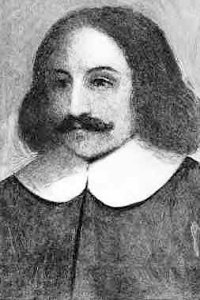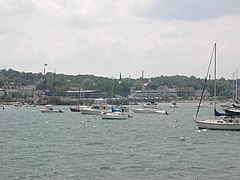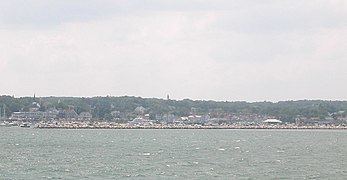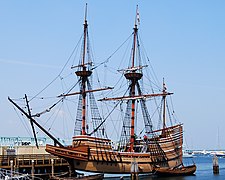
Plymouth Colony was an English colonial venture in America from 1620 to 1691 at a location that had previously been surveyed and named by Captain John Smith. The settlement served as the capital of the colony and developed as the town of Plymouth, Massachusetts. At its height, Plymouth Colony occupied most of the southeastern portion of Massachusetts.

William Bradford was an English Puritan separatist originally from the West Riding of Yorkshire in Northern England. He moved to Leiden in Holland in order to escape persecution from King James I of England, and then emigrated to the Plymouth Colony on the Mayflower in 1620. He was a signatory to the Mayflower Compact and went on to serve as Governor of the Plymouth Colony intermittently for about 30 years between 1621 and 1657. His journal Of Plymouth Plantation covered the years from 1620 to 1646 in Plymouth.

Plymouth is a town in Plymouth County, Massachusetts. The town holds a place of great prominence in American history, folklore, and culture, and is known as "America's Hometown." Plymouth was the site of the colony founded in 1620 by the Mayflower Pilgrims, where New England was first established. It is the oldest municipality in New England and one of the oldest in the United States. The town has served as the location of several prominent events, one of the more notable being the First Thanksgiving feast. Plymouth served as the capital of Plymouth Colony from its founding in 1620 until the colony's merger with the Massachusetts Bay Colony in 1691. The English explorer John Smith named the area Plymouth and the region 'New England' during his voyage of 1614. It was a later coincidence that, after an aborted attempt to make the 1620 trans-Atlantic crossing from Southampton, the "Mayflower" finally set sail for America from Plymouth, England.

Plymouth Rock is the traditional site of disembarkation of William Bradford and the Mayflower Pilgrims who founded Plymouth Colony in December 1620. The Pilgrims did not refer to Plymouth Rock in any of their writings; the first known written reference to the rock dates to 1715 when it was described in the town boundary records as "a great rock." The first documented claim that Plymouth Rock was the landing place of the Pilgrims was made by Elder Thomas Faunce in 1741, 121 years after the Pilgrims arrived in Plymouth.

Edward Winslow was a Separatist who traveled on the Mayflower in 1620. He was one of several senior leaders on the ship and also later at Plymouth Colony. Both Edward Winslow and his brother, Gilbert Winslow signed the Mayflower Compact. In Plymouth he served in a number of governmental positions such as assistant governor, three times was governor and also was the colony's agent in London. In early 1621 he had been one of several key leaders on whom Governor Bradford depended after the death of John Carver. He was the author of several important pamphlets, including Good Newes from New England and co-wrote with William Bradford the historic Mourt's Relation, which ends with an account of the First Thanksgiving and the abundance of the New World. In 1655 he died of fever while on an English naval expedition in the Caribbean against the Spanish.

Plimoth Plantation is a living history museum in Plymouth, Massachusetts, founded in 1947. It attempts to replicate the original settlement of the Plymouth Colony established in the 17th century by the English colonists who became known as the Pilgrims. They were among the first people who immigrated to America to seek religious separation from the Church of England. It is a not-for-profit museum supported by Administrations, contributions, grants, and volunteers. The re-creations are based upon a wide variety of first-hand and second-hand records, accounts, articles, and period paintings and artifacts, and the museum conducts ongoing research and scholarship, including historical archaeological excavation and curation locally and abroad.
Speedwell was a 60-ton pinnace that, along with Mayflower, transported the Pilgrims and was the smaller of the two ships. A vessel of the same name and size traveled to the New World seventeen years prior as the flagship of the first expedition of Martin Pring.

William Brewster was an English official and Mayflower passenger in 1620. In Plymouth Colony, by virtue of his education and existing stature with those immigrating from the Netherlands, Brewster, a Brownist, became senior elder and the leader of the community.

Cape Cod Bay is a large bay of the Atlantic Ocean adjacent to the U.S. state of Massachusetts. Measuring 604 square miles (1,560 km2) below a line drawn from Brant Rock in Marshfield to Race Point in Provincetown, Massachusetts, it is enclosed by Cape Cod to the south and east, and Plymouth County, Massachusetts, to the west. To the north of Cape Cod Bay lie Massachusetts Bay and the Atlantic Ocean. Cape Cod Bay is the southernmost extremity of the Gulf of Maine. Cape Cod Bay is one of the bays adjacent to Massachusetts that give it the name Bay State. The others are Narragansett Bay, Buzzards Bay, and Massachusetts Bay.
John Howland accompanied the English Separatists and other passengers when they left England on the Mayflower to settle in Plymouth. He was an indentured servant and in later years an executive assistant and personal secretary to Governor John Carver.

Richard Warren was one of the passengers on the Pilgrim ship Mayflower and the twelfth signer of the Mayflower Compact.

The Pilgrim Hall Museum at 75 Court Street in Plymouth, Massachusetts is the oldest public museum in the United States in continuous operation, having opened in 1824.

Plymouth Bay is a small, well-protected bay of the Atlantic Ocean on the western shore of larger Cape Cod Bay along the coastline of the Commonwealth of Massachusetts. Plymouth Bay retains historical significance for the landing at Plymouth Rock in 1620 by the Pilgrims aboard the Mayflower who proceeded to establish the first permanent Northern European settlement in North America at Plymouth Colony.

Clark's Island is the name of a small island located in Duxbury Bay in the U.S. state of Massachusetts. It was named for John Clark, the first mate of the Mayflower, the ship that brought the Pilgrims to New England. The island was initially considered for the location of the Pilgrim's settlement, but was rejected in favor of a site to the south, which became known as Plymouth, Massachusetts. Today Clark's Island is a part of the town of Plymouth.

White Horse Beach is a village of Plymouth, Massachusetts, United States. It is located on Cape Cod Bay, south of Priscilla Beach. Much of the southern end of the beach, which is also known as Taylor Avenue Beach, south of the outflow of Bartlett Pond, either has cottages on it or has a fenced off conservation area to protect the dunes and fragile plant life.

Cole's Hill is a National Historic Landmark containing the first cemetery used by the Mayflower Pilgrims in Plymouth, Massachusetts in 1620. The hill is located on Carver Street near the foot of Leyden Street and across the street from Plymouth Rock. Owned since 1820 by the preservationist Pilgrim Society, it is now a public park.

Mayflower was an English ship that transported a group of English families known today as the Pilgrims from England to the New World in 1620. After a grueling 10 weeks at sea, the Mayflower, with 102 passengers and a crew of about 30, reached America, dropping anchor near the tip of Cape Cod, Massachusetts, on November 21 [O.S. November 11], 1620.

Leyden Street, is a street in Plymouth, Massachusetts that was created in 1620 by the Pilgrims, and claims to be the oldest continuously inhabited street in the thirteen colonies of British North America.

Resolved White was a passenger on the Pilgrim ship Mayflower. In 1620, he accompanied his parents, Pilgrims William and Susanna White, on the journey. He married Judith Vassall, daughter of William Vassall, a founder of the Massachusetts Bay Colony. Later in life White became a notable person of Plymouth Colony.























